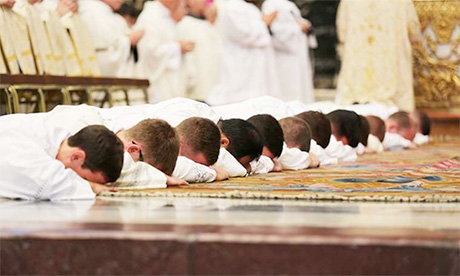Celibacy in the priesthood is once again up for discussion.
The diminished number of candidates for ordination and the abuse crisis have prodded the discussion, which seems mainly focused on the elimination of celibacy as a mandatory discipline for priests in the Western church.
But a more foundational concern, in my estimation, needs our reflection before we consider any change.
That concern has to do with formation for celibacy and formation in celibacy.
To resolve or even address the problem of sexual abuse in the Catholic Church, many people insist that the church must do away with mandatory celibacy for priests.
If you give priests a healthy outlet for their sex drive, the thinking goes, they will not abuse minors.
It sounds simple.
And it echoes an ancient take on the purpose of marriage as remedium concupiscentiae, a remedy for concupiscence.
Here it doubles as a remedy for abuse as well.
The elimination of priestly celibacy, however, would not eliminate abuse.
Noncelibate and in many cases married men are overwhelmingly the perpetrators of sexual abuse against minors.
First, let me state the obvious.
Sex—in its various dimensions: physical, emotional and even spiritual—is a powerful force.
It is a gift of God, and it also carries the burdens of our wounded human condition.
Everyone, no matter their gender, orientation or marital status, needs to integrate their sexuality.
The elimination of priestly celibacy, however, would not eliminate abuse.
Noncelibate and in many cases married men are overwhelmingly the perpetrators of sexual abuse against minors.
Ultimately, in the Christian vision, this transformative process leads to self-acceptance and self-gift.
The transformation and integration of sexuality represents a universal human task.
It does, however, take on a specific shape in the instance of priests who commit themselves to celibate living.
The situation of priests
For celibate priests, there are three specific and essential elements of formation for sustaining their commitment: They need a meaningful reason for celibacy, they need skills for celibate living, and they need a supportive community.
Given the challenges and obstacles for priests to live the celibate life well, it might seem better to change the current discipline of the Western church and make celibacy optional.
But much more reflection is needed to understand the positive value of the current discipline.
The church’s persistence in maintaining this practice, in the face of great difficulties and even its nonobservance in certain historical contexts, suggests something that deserves careful spiritual discernment to detect the promptings of the Holy Spirit.
A consideration of the three indispensable elements that make celibacy possible and real—a reason, skills and a supportive community—can actually contribute to a fuller reflection and discernment.
Celibacy is not an ordinary choice.
Making the choice for celibacy requires a very deliberate decision based on a clear and even compelling reason.
That reason, motivation or rationale may take on different shapes, as we will see, but it must be in place for the decision to be made and to be sustained over a lifetime.
At the same time, although a motivating and meaningful reason for celibacy is essential, by itself it is insufficient.
Knowing how to live out this commitment is also necessary.
In other words, celibates also need to be in possession of those life skills that enable them to stay faithful, productive and joyful in their way of life.
To summarize: Celibates need a reason, skills for living and a supportive community.
A quick historical survey can help us understand these elements more deeply and identify today’s challenges more precisely.
Historical context for priestly celibacy
The history of celibacy for the sake of the kingdom of God begins in the New Testament. Celibacy and consecrated virginity stretch across the whole trajectory of Christian history.
The more specific history of celibacy attached to holy orders has had many complex turns for both the Eastern and Western churches. Continue reading
- Image: Mercatornet
